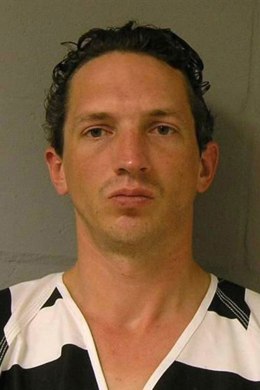
Israel Keyes
Israel Keyes was buried on Sunday in a sparsely attended service in Deer Park, Wash., ending a decade-long spree of kidnapping, larceny and murder that authorities weren’t even aware of until earlier this year. Keyes, an itinerant construction worker and Army veteran, is believed to have murdered at least eight people across the U.S. — leaving behind a legacy that’s almost as much an enigma as it is a nightmare.
(MORE: FBI Releases Details in Alaska Serial Killer Death)
The beginning of the end of Keyes’ killing spree came on Feb. 1, when he abducted Samantha Koenig, 18, from the Anchorage, Ak., coffee shop where she worked. Keyes allegedly stole her debit card and used her cellphone to send text messages intended to hide her kidnapping, according to an indictment. He forced her to give him the PIN number, then killed her the next day. Her body was found in a frozen lake north of Anchorage.
Keyes flew to Houston, then back to Anchorage, where he demanded ransom money be deposited into her account, which he withdrew using her debit card. He continued to make withdrawals from the account while traveling between several states including Arizona, Nevada, New Mexico and Texas.
Those bank trips proved to be his undoing. On March 13, a highway patrolman in Lufkin, Texas pulled over Keyes’ Ford Focus after recognizing it from an ATM security video. He found a large amount of cash in the vehicle, and disguises Keyes had used in the withdrawals. Police also found Koenig’s cellphone, whose battery was removed so it couldn’t be tracked, according to the Anchorage Daily News. Once in custody and extradited to Alaska, Keyes confessed to Koenig’s murder and told authorities where he placed her body — and then began talking about his other kidnappings and muders. Facing a possible death sentence, Keyes slit his own wrists and strangled himself to death with his bedding in his jail cell on Dec. 2. It is not known if he told authorities about every murder he committed.
(MORE: Understanding Psychopathic and Sadistic Minds)
“He derived pleasure from it,” FBI special agent Eric Hernandez tells TIME. “Remorseful isn’t a word investigators would use to describe him.”
According to the FBI, Keyes’ crime spree began as early as 2001. During interviews, he implicated himself in the murders of four people in Washington, two couples independent of each other. They also believe he killed a person on the east coast and took the body to upstate New York to dispose of it. He may have also sexually assaulted a young Oregon girl in the 1990s, although according to FBI special agent Jolene Goeden, Keyes said he’d let the girl go.
It was not unusual for Keyes to methodically plan his murders before carrying them out. That was evident in the deaths of Bill and Lorraine Currier, a Vermont couple whose bodies were never found after their 2011 disappearance. Federal agents say Keyes flew to Chicago, rented a car and drove cross-country to the Curriers’ hometown of Essex, Vermont, where he reportedly broke into their house and abducted them. Police had no idea who could have committed the crime until Keyes admitted that he had stashed a cache of weapons in the woods near Essex — weapons which he later used to kill the Curriers. He then took the weapons to Parishville, N.Y., and hid them again, this time including a gun belonging to the Curriers.
(MORE: Serial Killer John Wayne Gacy May Have Had Accomplices)
This was a method Keyes employed several times, the FBI said. “Keyes also admitted traveling to various locations to leave supplies he planned to use in a future crime,” said Special Agent Mary Rook in a statement. “Keyes buried caches throughout the United States: burying weapons in strategic places around the country to use in future murders.”
“Prior to Keyes’ capture, there was no sense that the abduction of Samantha [Koenig] had any connection with what happened to the Curriers,” special agent Hernandez tells TIME. “It was when we interviewed Keyes that the pieces started to fall into place.”
The closest thing to a pattern in Keyes’ crimes were his tendencies to look for his victims in open areas like campgrounds, parks, wildernesses and the like. He openly discussed his cunning on a video released by the FBI. “Back when I was smart,” he said, “I would let them come to me, kind of in a remote area that’s not anywhere near where you live, but that other people go to as well.
“You might not get exactly what you’re looking for, there’s not much to choose from in a manner of speaking,” said Keyes. “But there’s also no witnesses, there’s nobody else around.”
Keyes was born in 1978 in Utah to a Mormon family, one of ten siblings. At some point, his family moved to Stevens County, Wash. The family home schooled the boy and sometimes attended The Ark, a white supremacist church linked with the Christian Identity movement, which is listed as a hate group by the Southern Poverty Law Center. He served in the U.S. Army from 1998 to 2000 and was honorably discharged, records show.
On Sunday, Keyes’ mother and four of his siblings showed up for his funeral. They were the only ones in attendance. “He is not in a better place,” said Jake Gardner, the pastor for Keyes’ family, before the service. “He’s in a place of eternal torment.”
One of his sisters had once tried to save him through their family’s religious faith without knowing his gruesome crimes, Gardner said. But to her, his response was: “You don’t know the depths of darkness that I’ve gone to. You don’t know what I’ve done.”






